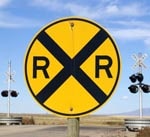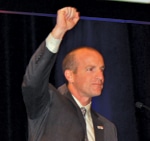
In response to the column, Missouri State Legislative Director Ken Menges told Previsich and Transportation Division National Legislative Director James Stem, “Your timing was impeccable. Just today (April 16), there was a hearing in the state Senate about a new transportation tax. The proposal has already passed in the House. Also, I am meeting now with a citizens’ passenger rail group about improving passenger rail transportation here in Missouri. Thank you for your leadership.”
The column by Previsich and Wytkind reads:
Stark divisions have defined our national politics for some time. But there are many transportation issues that unite Americans across political lines, and one of those is overwhelming support for passenger rail in this country, and in particular, for Amtrak.
Recent polls in America’s heartland have shown huge support for our national passenger rail system, Amtrak.
Missouri is no exception.
Red, blue or purple, 82 percent of Missourians want to increase or maintain passenger rail service in the state. And seven in 10 want to increase or maintain Amtrak’s current funding levels, according to a survey conducted by DFM Research. The elected leaders who will hold Amtrak’s fate in their hands during this congressional session need to recognize an important fact uncovered by this poll — the support for Amtrak is deep, and it is nonpartisan.
It’s not only in St. Louis and Kansas City that support for Amtrak is high. Even in northern, central and southern Missouri, where ridership is lower – and voters tend to be more conservative – strong majorities say they value passenger rail service and want to fund it.
The polls measure support that has been very real on station platforms for several years. Nationwide, Amtrak ridership is at an all-time high. About 31.6 million passengers rode Amtrak last year, thanks to increased use of routes in all regions, not just in the heavily traveled Northeast Corridor. The railroad’s ridership has set records in 10 of the last 11 years, and is up more than 50 percent since 2000.
Here in Missouri, ridership on all Amtrak lines, including the Missouri River Runner, the Texas Eagle and the Southwest Chief, reached 774,000 last year, up 4.7 percent from 2012.
The Missouri findings mirror those of recent polls in Pennsylvania, Iowa, Colorado, Indiana, Illinois, Kansas and Kentucky. Clearly, Americans understand that a well-financed, well-maintained passenger rail network is essential to an integrated national transportation system.
Investing in Amtrak and the development it attracts is also good business. Since 2010, every federal dollar invested in Amtrak pours $3 back into the economy. That’s why many business leaders understand that long-term economic growth depends on investment in our multi-modal transportation infrastructure – and expanded passenger rail must be part of the picture.
To deliver on what the people of Missouri want will require more federal investment and an end to the political attacks on Amtrak and its employees that seem to spring up annually. Amtrak is operating with infrastructure that was built in the middle of the last century, and yet Americans continue to ride on Amtrak in record numbers – and to tell Congress they want and need more rail service.
But a well-funded and accessible Amtrak system isn’t all that Missourians say they want. They also want the freight trains that traverse annually across Missouri carrying 16 million tons of freight (including more than 24,000 carloads of chemicals) to be as safe as possible. About 8 in 10 Missourians agree that one-person freight train crews should be barred in favor of mandatory two-person crew operations. This is not an academic debate. There are single-member freight train crews out there — in fact, last year’s fiery crash of a freight train in Quebec was run by a one-person crew. Fortunately, legislation is pending before Congress that would make two-person crews mandatory, just the way Missourians would have it.
Political views and ideology aside, the people of Missouri clearly want more Amtrak service, not less. They also want freight trains that are safe and properly crewed. It is time for lawmakers, with the rewrite of federal rail laws now pending, to tone down the partisanship and start listening to what Missourians and the vast majority of Americans are saying.
 WASHINGTON – In a new report updating the industry’s progress on installing positive train control, the nation’s freight railroads said that a year-long moratorium on installing 20,000 communication antennas imposed by the Federal Communications Commission, followed by a lengthy federal approval process mandated by the agency, has seriously delayed the implementation of nationwide interoperable PTC. Whereas freight railroads once projected that by 2015 they would have PTC installed on 40 percent of the network mandated by FRA, they now believe thanks to the FCC issues only 20 percent of the PTC network will be up and running by the Congressionally imposed deadline.
WASHINGTON – In a new report updating the industry’s progress on installing positive train control, the nation’s freight railroads said that a year-long moratorium on installing 20,000 communication antennas imposed by the Federal Communications Commission, followed by a lengthy federal approval process mandated by the agency, has seriously delayed the implementation of nationwide interoperable PTC. Whereas freight railroads once projected that by 2015 they would have PTC installed on 40 percent of the network mandated by FRA, they now believe thanks to the FCC issues only 20 percent of the PTC network will be up and running by the Congressionally imposed deadline.
 A central element of the Congressional Budget process, established in 1974, is that policy proposals affecting the balance between spending and revenues must be scored by a philosophically neutral organization, one created for the purpose of making sure Congress clearly understands the budgetary effect of the legislation brought before it. That duty was given to the Congressional Budget Office, or CBO.
A central element of the Congressional Budget process, established in 1974, is that policy proposals affecting the balance between spending and revenues must be scored by a philosophically neutral organization, one created for the purpose of making sure Congress clearly understands the budgetary effect of the legislation brought before it. That duty was given to the Congressional Budget Office, or CBO.